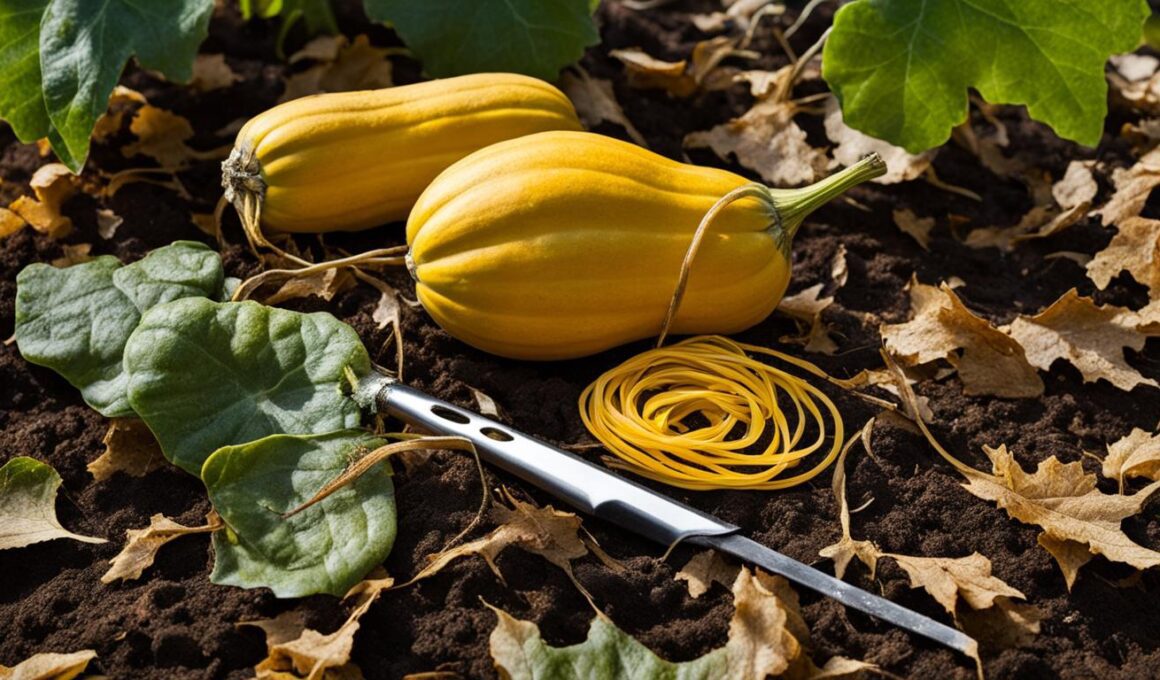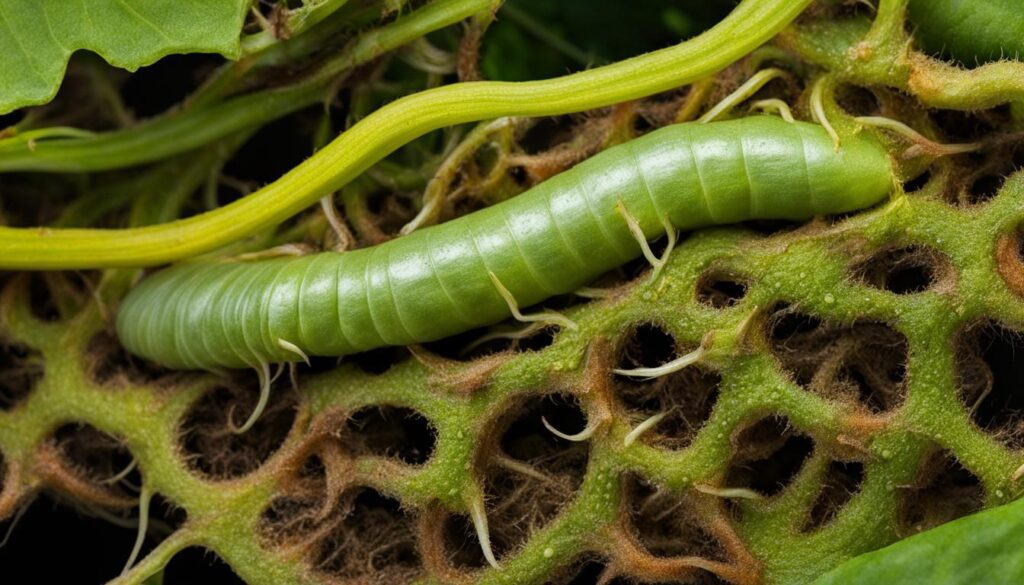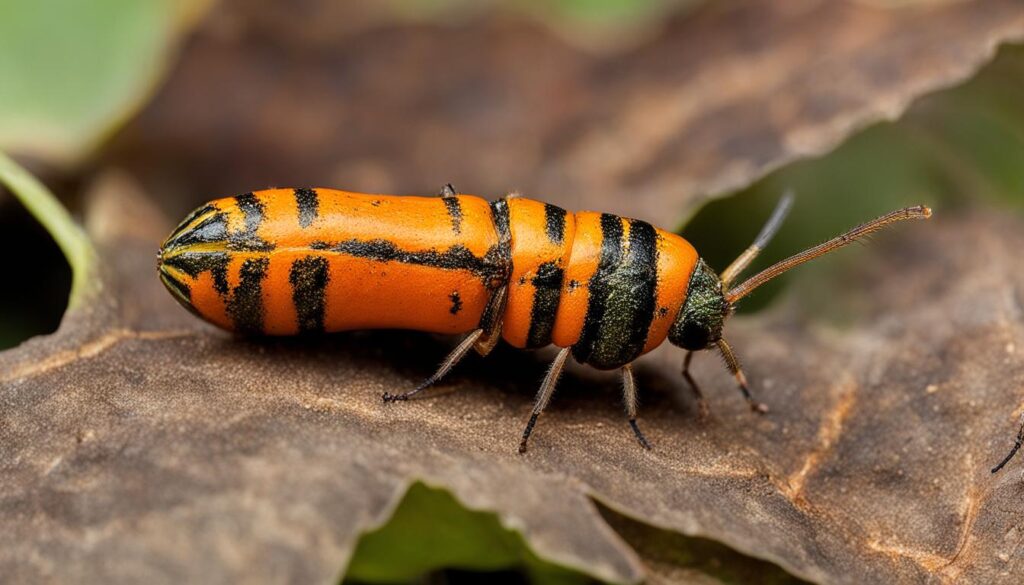Welcome to our comprehensive guide on dealing with worms in squash. If you’re a passionate gardener or farmer, you know how frustrating it can be to find these destructive pests wreaking havoc on your beloved squash plants. But fear not! In this article, we will provide you with effective solutions and prevention tips to help you protect your squash and ensure a healthy harvest. Let’s dive in!
Key Takeaways:
- Early detection and prevention are crucial in managing worms in squash.
- Identify squash vine borers by their eggs, larvae, and adult moths.
- Preventive measures include early planting, crop rotation, and physical barriers.
- Control methods include manual removal, insecticides, and biological control.
- Managing squash vine borers requires a combination of strategies in home gardens and farms.
What Are Squash Vine Borers?
Squash vine borers are the larvae of an orange and black sesiid moth. These moths lay their eggs on squash plants, and when the eggs hatch, the larvae burrow into the stems of the plants and feed on them. The adult moths are diurnal and often mistaken for wasps due to their similar appearance. The larvae of squash vine borers can cause significant damage to squash plants, leading to wilting and eventually death.
The life cycle of squash vine borers starts with the moth laying eggs on the leaves or stems of squash plants. The eggs are small and brown, typically laid at the base of the plant. Once the eggs hatch, the larvae emerge and begin tunneling into the stems, where they feed and grow. As they burrow deeper into the plant, they cause damage and disrupt the flow of nutrients, resulting in wilting and plant death.
To effectively control squash vine borers, it is important to be able to identify them. The adult moths are about 1/2 inch long and have a gray or black body with orange-red markings. The larvae are white or cream-colored with brown heads and can grow up to an inch in length. Signs of squash vine borer damage include wilting, holes at the base of the plant, and frass (chewed up stem) around the openings.
Understanding the life cycle and appearance of squash vine borers is crucial in implementing effective prevention and control strategies. By knowing what to look for, you can take the necessary steps to protect your squash plants from these destructive pests.
How to Identify Squash Vine Borers
In order to effectively control squash vine borers, it is important to be able to identify them. Here are some key characteristics to look for:
- The eggs of squash vine borers are small and brown. They are typically laid at the base of squash plants.
- The larvae of squash vine borers are white or cream-colored with brown heads. They can grow to about an inch in length.
- The adult moths of squash vine borers are about 1/2 inch long and have a gray or black body with orange-red markings.
When inspecting your squash plants, keep an eye out for these signs of squash vine borer damage:
- Wilting of the plant, even with ample moisture.
- Holes near the base of the plant, where the larvae have burrowed in.
- Frass, or chewed up stem, around the openings made by the larvae.
By familiarizing yourself with the appearance of squash vine borers and the signs of their presence, you can take early action to control and prevent further damage to your squash plants.
Tips for Identification
“Inspect your squash plants regularly, especially during the summer months when squash vine borers are actively laying eggs. Look for the small brown eggs at the base of the plants and check for any signs of wilting or damage to the stems. Taking the time to properly identify squash vine borers will help you implement effective control measures and protect your squash plants from further infestation.”
– Gardening Expert
Prevention of Squash Vine Borers
To protect your squash plants from vine borers, it is important to implement preventive measures. By taking steps early on, you can significantly reduce the risk of infestation and ensure the health and productivity of your squash garden. Here are some effective prevention strategies:
- Early planting: Start your squash plants early in the season to allow them to establish strong roots and become more resistant to vine borer attacks. This will give them a head start and increase their chances of survival.
- Crop rotation: Avoid planting squash in the same area two years in a row. Squash vine borers overwinter in the soil, so rotating your crops will help disrupt their life cycle and decrease the chances of reinfestation.
- Physical barriers: Use row covers or create physical barriers around your squash plants to prevent adult moths from laying eggs on them. This will effectively block their access to the plants and reduce the risk of infestation.
Additionally, planting squash varieties that are known to be resistant to vine borers, such as butternut squash, can provide an extra layer of protection. These resistant varieties have natural defenses against the borers and are less likely to be targeted.
By following these preventive measures, you can safeguard your squash plants from vine borers and enjoy a bountiful harvest.
How to Get Rid of Squash Vine Borers
If you discover squash vine borers in your squash plants, it’s important to take action to minimize their damage and protect your crop. Here are some effective methods for getting rid of squash vine borers:
- Manual Removal: If you catch the infestation early, you can manually remove the larvae by slitting the stem and physically removing them. This method can be time-consuming but can effectively control the population if done promptly.
- Insecticides: Insecticides containing carbaryl or permethrin can be used to treat squash vine borers. However, timing is crucial for their effectiveness. Apply the insecticide when the adult moths are active, usually in early morning or late evening.
- Biological Control: Introducing parasitic wasps or using pheromone traps can help control squash vine borers naturally. Parasitic wasps lay their eggs inside the borer larvae, eventually killing them. Pheromone traps attract and trap the adult moths, reducing their population.
- Protective Measures: Implementing physical barriers like row covers or covering the stems with mulch can prevent adult moths from laying eggs on the plants. Additionally, using natural remedies like diatomaceous earth can provide a protective barrier against the borers.
It’s important to note that while these methods can help control squash vine borers, prevention is key. By implementing preventive measures earlier in the growing season, such as crop rotation, planting resistant varieties, and practicing good garden hygiene, you can reduce the chances of squash vine borer infestations.
Remember to regularly monitor your squash plants for any signs of infestation and take prompt action to prevent the spread of the borers. By combining these methods and staying vigilant, you can effectively get rid of squash vine borers and safeguard your squash crop.
Managing Squash Vine Borers in Home Gardens and Farms
When it comes to managing squash vine borers in your home garden or farm, a combination of exclusion methods, trap cropping, and targeted insecticides can be effective. These strategies will help you protect your squash plants and minimize the damage caused by these destructive pests.
1. Exclusion Methods:
To prevent squash vine borer infestations, consider using exclusion methods such as floating row covers or physical barriers. These can effectively block the adult moths from laying their eggs on your squash plants. By creating a physical barrier, you can significantly reduce the risk of infestation and protect your crops.
2. Trap Cropping:
Implementing trap cropping techniques can help divert squash vine borers away from your main crop. Planting varieties of squash that are particularly attractive to the borers can lure them away from your desired plants. This technique can be especially useful in larger-scale farming operations where trap crops can be strategically positioned.
3. Targeted Insecticides:
If infestation occurs despite your prevention efforts, targeted insecticides can be used as a last resort. However, it is important to follow label instructions carefully and consider the impact on beneficial insects. Applying insecticides at the right time is crucial for their effectiveness, so monitor your squash plants closely and take action at the first sign of squash vine borer activity.
By implementing a combination of exclusion methods, trap cropping, and targeted insecticides, you can effectively manage squash vine borers in your home garden or farm. Regular monitoring of your plants and taking prompt action are key to controlling these pests and safeguarding your squash crop.
Conclusion
Squash vine borers can be a major threat to your squash plants, but there are effective solutions and prevention tips to help you combat these worms. By implementing the right strategies, you can protect your garden and enjoy a bountiful harvest.
Early detection is key when it comes to managing squash vine borers. Regularly monitor your plants for signs of wilting, holes at the base, and frass. By identifying the presence of squash vine borers early on, you can take prompt action and prevent further damage.
Prevention is crucial in keeping your squash plants healthy. Consider using organic methods like applying Bt spray, which targets the larvae of squash vine borers. Mulching the stems with materials like straw or leaves can also create a physical barrier that prevents egg-laying by the adult moths.
Remember to start your squash plants early, practice crop rotation, and consider planting borers-resistant varieties. These prevention tips can help minimize the risk of squash vine borer infestation and ensure the health and productivity of your squash garden.
Can Squash Vine Borers also cause Worms in Squash and how to prevent it?
Yes, squash vine borers can cause worms in squash by burrowing into the stems and causing damage. To combat squash vine borer infestations, you can use row covers to protect young plants, handpick and destroy eggs, and apply insecticides as a last resort. Proper crop rotation can also help prevent future infestations.
FAQ
What are squash vine borers?
Squash vine borers are the larvae of an orange and black sesiid moth. These moths lay their eggs on squash plants, and when the eggs hatch, the larvae burrow into the stems of the plants and feed on them.
How can I identify squash vine borers?
The eggs of squash vine borers are small, brown, and laid at the base of squash plants. The larvae are white or cream-colored with brown heads and grow to about an inch in length. The adult moths are about 1/2 inch long and have a gray or black body with orange-red markings.
How can I prevent squash vine borers?
Prevention is crucial in protecting squash plants from vine borers. Starting your squash plants early, crop rotation, using physical barriers such as row covers or mulch, and planting borer-resistant varieties can all help prevent squash vine borer infestations.
How can I get rid of squash vine borers?
If you already have squash vine borers in your squash plants, manual removal of the larvae, using insecticides containing carbaryl or permethrin, introducing parasitic wasps or using pheromone traps, protecting plants with physical barriers, or using natural remedies like diatomaceous earth can help control squash vine borers.
How can I manage squash vine borers in my garden or farm?
Managing squash vine borers requires a combination of strategies. Exclusion methods like using floating row covers or physical barriers, trap cropping, and careful use of insecticides can help control squash vine borers in home gardens and farms.












